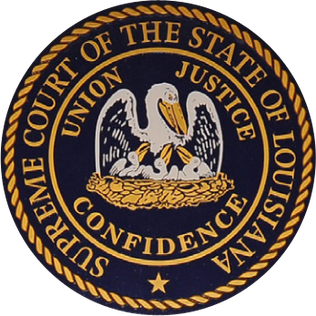Related Research Articles

Article Three of the United States Constitution establishes the judicial branch of the U.S. federal government. Under Article Three, the judicial branch consists of the Supreme Court of the United States, as well as lower courts created by Congress. Article Three empowers the courts to handle cases or controversies arising under federal law, as well as other enumerated areas. Article Three also defines treason.
In the United States, a state court has jurisdiction over disputes with some connection to a U.S. state. State courts handle the vast majority of civil and criminal cases in the United States; the United States federal courts are far smaller in terms of both personnel and caseload, and handle different types of cases. States often provide their trial courts with general jurisdiction and state trial courts regularly have concurrent jurisdiction with federal courts. Federal courts are courts of limited jurisdiction and their subject-matter jurisdiction arises only under federal law.

The federal government of the United States is the national government of the United States, a federal republic located primarily in North America, composed of 50 states, five major self-governing territories, several island possessions, and the federal district and national capital of Washington, D.C., where most of the federal government is based.

A justice of the peace (JP) is a judicial officer of a lower court, elected or appointed by means of a commission to keep the peace. In past centuries the term commissioner of the peace was often used with the same meaning. Depending on the jurisdiction, such justices dispense summary justice or merely deal with local administrative applications in common law jurisdictions. Justices of the peace are appointed or elected from the citizens of the jurisdiction in which they serve, and are usually not required to have any formal legal education in order to qualify for the office. Some jurisdictions have varying forms of training for JPs.
In common law systems, a superior court is a court of general jurisdiction over civil and criminal legal cases. A superior court is "superior" in relation to a court with limited jurisdiction, which is restricted to civil cases involving monetary amounts with a specific limit, or criminal cases involving offenses of a less serious nature. A superior court may hear appeals from lower courts. For courts of general jurisdiction in civil law system, see ordinary court.

The United States District Court for the District of Montana is the United States District Court whose jurisdiction is the state of Montana. The court is located in Billings, Butte, Great Falls, Helena and Missoula.
The structure of the judiciary of Texas is laid out in Article 5 of the Constitution of Texas and is further defined by statute, in particular the Texas Government Code and Texas Probate Code. The structure is complex, featuring many layers of courts, numerous instances of overlapping jurisdiction, several differences between counties, as well as an unusual bifurcated appellate system at the top level found in only one other state: Oklahoma. Municipal Courts are the most active courts, with County Courts and District Courts handling most other cases and often sharing the same courthouse.
The Superior Court is the state court in the U.S. state of New Jersey, with statewide trial and appellate jurisdiction. The New Jersey Constitution of 1947 establishes the power of the New Jersey courts. Under the State Constitution, "'judicial power shall be vested in a Supreme Court, a Superior Court, County Courts and inferior courts of limited jurisdiction.'" The Superior Court has three divisions: the Appellate Division is essentially an intermediate appellate court while the Law and Chancery Divisions function as trial courts. The State Constitution renders the New Jersey Superior Court, Appellate Division the intermediate appellate court, and "[a]ppeals may be taken to the Appellate Division of the Superior Court from the law and chancery divisions of the Superior Court and in such other causes as may be provided by law." Each division is in turn divided into various parts. "The trial divisions of the Superior Court are the principal trial courts of New Jersey. They are located within the State's various judicial geographic units, called 'vicinages,' R. 1:33-2(a), and are organized into two basic divisions: the Chancery Division and the Law Division".

The government of the U.S. State of Oklahoma, established by the Oklahoma Constitution, is a republican democracy modeled after the federal government of the United States. The state government has three branches: the executive, legislative, and judicial. Through a system of separation of powers or "checks and balances," each of these branches has some authority to act on its own, some authority to regulate the other two branches, and has some of its own authority, in turn, regulated by the other branches.

The Supreme Court of Louisiana is the highest court and court of last resort in the U.S. state of Louisiana. The modern Supreme Court, composed of seven justices, meets in the French Quarter of New Orleans.

The Montana Supreme Court is the highest court of the state court system in the U.S. state of Montana. It is established and its powers defined by Article VII of the 1972 Montana Constitution. It is primarily an appellate court which reviews civil and criminal decisions of Montana's trial courts of general jurisdiction and certain specialized legislative courts, only having original jurisdiction in a limited number of actions. The court's Chief Justice and six Associate Justices are elected by non-partisan, popular elections. The Montana Supreme Court meets in the Joseph P. Mazurek Building in Helena, Montana, the state's capital, an international style building completed in 1982 and named in the honor of former Montana Attorney General, Joseph P. Mazurek.

Superior courts in California are the state trial courts with general jurisdiction to hear and decide any civil or criminal action which is not specially designated to be heard in some other court or before a governmental agency. As mandated by the California Constitution, there is a superior court in each of the 58 counties in California. The superior courts also have appellate divisions which hear appeals from decisions in cases previously heard by inferior courts.

As established and defined by the Montana Constitution, the government of the State of Montana is composed of three branches, the Executive, Judicial, and Legislative. The powers of initiative and referendum are reserved for the citizens of Montana.

The Judiciary of Spain consists of Courts and Tribunals, composed of judges and magistrates (Justices), who have the power to administer justice in the name of the King of Spain.
United States v. More, 7 U.S. 159 (1805), was a United States Supreme Court case in which the Court held that it had no jurisdiction to hear appeals from criminal cases in the circuit courts by writs of error. Relying on the Exceptions Clause, More held that Congress's enumerated grants of appellate jurisdiction to the Court operated as an exercise of Congress's power to eliminate all other forms of appellate jurisdiction.

The Judiciary of Louisiana is defined under the Constitution and law of Louisiana and is composed of the Louisiana Supreme Court, the Louisiana Circuit Courts of Appeal, the District Courts, the Justice of the Peace Courts, the Mayor's Courts, the City Courts, and the Parish Courts. The Chief Justice of the Louisiana Supreme Court is the chief administrator of the judiciary, and its administration is aided by the Judiciary Commission of Louisiana, the Louisiana Attorney Disciplinary Board, and the Judicial Council of the Supreme Court of Louisiana.
The judiciary of Ohio is the branch of the government of Ohio that interprets and applies the law of Ohio, ensures equal justice under law, and provides a mechanism for dispute resolution. The court of last resort is the Ohio Supreme Court.

Montana District Courts are the state trial courts of general jurisdiction in the U.S. state of Montana. Montana District Courts have original jurisdiction over most civil cases, civil actions involving monetary claims against the state, criminal felony cases, naturalization proceedings, probate cases, and most writs. They may also hear certain special actions and proceedings, and oversee a narrowly-defined class of ballot issues. Montana District Courts also have limited appellate jurisdiction regarding cases that arise in Justice Courts, City Courts, and Municipal Courts as well as Judicial review of decisions by state administrative law tribunals that fall under the Montana Administrative Procedures Act.
Montana Youth Courts are courts of law in the U.S. state of Montana which have jurisdiction over any minor charged with violating any state law or city and county city ordinance, except for fish and game ordinance violations and traffic violations. Appeals from Youth Courts are made directly to the Montana Supreme Court.
BNSF Railway Co. v. Tyrrell, 581 U.S. ___, 137 S. Ct. 1549 (2017), was a United States Supreme Court case in which the Court held that the Montana courts lacked personal jurisdiction over a railroad that was not incorporated in Montana and did not have its principal place of business in Montana, even though the railroad had more than 2,000 miles of track and 2,000 employees within Montana. It was the first Supreme Court case argued before a Court that included newly appointed Associate Justice Neil Gorsuch.
References
- ↑ Constitution of the State of Montana, Article VIII, §1, §§20-23 (1889).
- 1 2 Constitution of the State of Montana, Article VIII, §24 (1889).
- ↑ Constitution of the State of Montana, Article VIII, §25 (1889).
- ↑ Constitution of the State of Montana, Article VIII, §20 (1889).
- ↑ Constitution of the State of Montana, Article VIII, §§221, 24 (1889).
- ↑ Elison & Snyder 2001, p. 144.
- ↑ Elison & Snyder 2001, p. 4.
- ↑ Montana Constitutional Convention (1972). Proposed 1972 Constitution for the State of Montana: Official Text With Explanation (Report). Helena, Mont. pp. 12–13. Retrieved February 24, 2017.
- ↑ State Bar of Montana 2010, pp. 3–4.
- 1 2 3 4 5 6 State Bar of Montana 2010, p. 3.
- ↑ https://leg.mt.gov/bills/mca/title_0460/chapter_0050/part_0020/section_0200/0460-0050-0020-0200.html
- ↑ https://leg.mt.gov/bills/mca/title_0460/chapter_0050/part_0020/section_0200/0460-0050-0020-0200.html
- ↑ https://leg.mt.gov/bills/mca/title_0460/chapter_0050/part_0020/section_0200/0460-0050-0020-0200.html
- ↑ Elison & Snyder 2001, p. 3.
- ↑ Montana Code Annotated, Title 3, Chapter 5, Part 3, §303.
- ↑ McDunn v. Arnold,303P.3d1279(Mont.2013).
- ↑ Montana Code Annotated, Title 3, Chapter 11, Part 1, §110.
- ↑ Montana Code Annotated, Title 3, Chapter 6, Part 1, §110.
- ↑ Siebken v. Voderberg,291P.3d572(Mont.2012).
- ↑ Office of the Court Administrator (January 22, 2013). Montana Drug Courts: An Updated Snapshot of Success and Hope (PDF) (Report). Helena, Mont.: Montana Supreme Court. p. 2. Retrieved February 26, 2017.